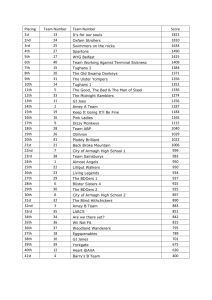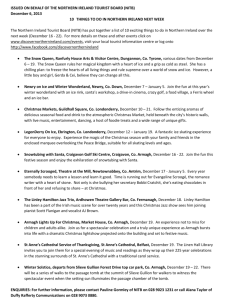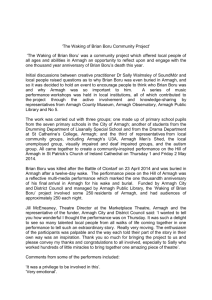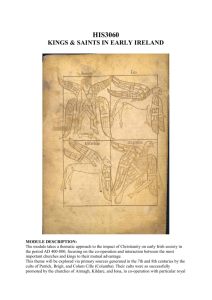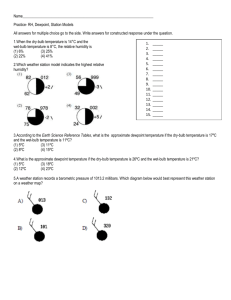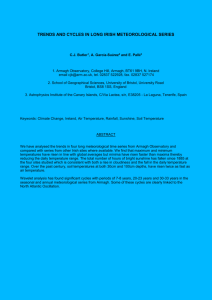Relative Humidity at Armagh Observatory, 1838-2006
advertisement
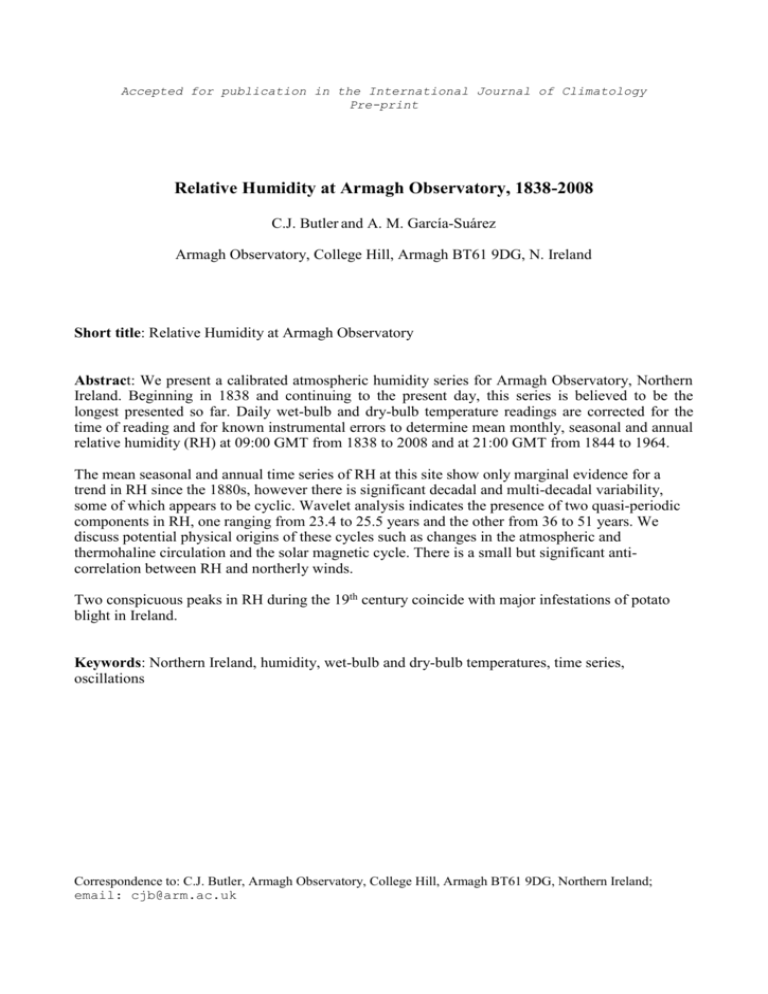
Accepted for publication in the International Journal of Climatology
Pre-print
Relative Humidity at Armagh Observatory, 1838-2008
C.J. Butler and A. M. García-Suárez
Armagh Observatory, College Hill, Armagh BT61 9DG, N. Ireland
Short title: Relative Humidity at Armagh Observatory
Abstract: We present a calibrated atmospheric humidity series for Armagh Observatory, Northern
Ireland. Beginning in 1838 and continuing to the present day, this series is believed to be the
longest presented so far. Daily wet-bulb and dry-bulb temperature readings are corrected for the
time of reading and for known instrumental errors to determine mean monthly, seasonal and annual
relative humidity (RH) at 09:00 GMT from 1838 to 2008 and at 21:00 GMT from 1844 to 1964.
The mean seasonal and annual time series of RH at this site show only marginal evidence for a
trend in RH since the 1880s, however there is significant decadal and multi-decadal variability,
some of which appears to be cyclic. Wavelet analysis indicates the presence of two quasi-periodic
components in RH, one ranging from 23.4 to 25.5 years and the other from 36 to 51 years. We
discuss potential physical origins of these cycles such as changes in the atmospheric and
thermohaline circulation and the solar magnetic cycle. There is a small but significant anticorrelation between RH and northerly winds.
Two conspicuous peaks in RH during the 19th century coincide with major infestations of potato
blight in Ireland.
Keywords: Northern Ireland, humidity, wet-bulb and dry-bulb temperatures, time series,
oscillations
Correspondence to: C.J. Butler, Armagh Observatory, College Hill, Armagh BT61 9DG, Northern Ireland;
email: cjb@arm.ac.uk
1. Introduction
Water vapour is constantly cycling through the atmosphere, evaporating from ocean and land
surfaces, condensing into clouds and subsequently returning to the ground as precipitation. These
processes, known as the hydrological cycle, are crucial to the Earth's climate. Whilst water vapour
is also the most abundant of the greenhouse gases, exceeding CO2 and other minor constituents of
the atmosphere by several times in its greenhouse contribution (Tyndall, 1861, Trenberth et al.
2007, p271), and critical for the habitability of the planet, its possible variability over recent
centuries has received little attention compared to temperature and precipitation (see also: Manabe
and Wetherald, 1967, Kiehl and Trenberth, 1997, Held and Soden, 2000 and Soden et al. 2005).
Relative humidity (RH) is one of the parameters used to quantify water vapour in the atmosphere. It
has been usually measured since the early 19th century by readings from a matched pair of wet and
dry-bulb thermometers. Though such data are common, they require careful calibration for known
instrumental errors and the time of reading. For these and other reasons, extended series are rare. It
is believed this may be the first long humidity series to be presented.
2. Data
A description of the site of Armagh Observatory (54° 21' 8.82", -6° 38' 58.50") and its environment
has been given by Butler et al. (2005a). In general, though situated within the boundaries of a small
historic cathedral city, its predominantly rural surroundings have ensured that there are no
detectable urban climatic effects (see Coughlin and Butler, 1998).
Meteorological observations began at Armagh Observatory in 1796, continued throughout the 19th
and 20th centuries (with a gap from 1825 to 1833), and are now some of the longest running sets of
observations from a single site in the British Isles. The climate series for this site have been
standardised taking into account all known metadata surviving in the Armagh Observatory and UK
Meteorological Office (UKMO) archives. The published series include: precipitation (Butler,
Coughlin and Fee, 1998; García-Suárez et al. 2002), air temperature (Butler et al. 2005a,b,c); soil
temperatures (García-Suárez and Butler, 2006, García-Suárez, Butler and Morrow, 2005); and
hours of bright sunshine (Pallé and Butler, 2001, Butler et al. 2005d). This paper extends the
Armagh series to include relative humidity. Additional papers on atmospheric pressure, specific
humidity, wind strength and direction are planned.
Daily wet-bulb and dry-bulb temperature readings in the morning commenced, initially
sporadically, in January 1836, gradually improving in regularity until 1840. From that year, to the
present day, they are largely complete (García-Suárez et al. 2007). Additional evening readings
were made from January 1844 to March 1965. The uncalibrated wet-bulb and dry-bulb temperature
data are contained in manuscript form in M117 of the Armagh Observatory Archives (Butler and
Hoskin, 1987) and can be accessed electronically via the Armagh Observatory Climate website
(http://climate.arm.ac.uk).
Before and after entry into computer file, considerable effort was taken to ensure accuracy of the
raw daily data. In the first instance, the meteorological observer, who was normally a permanent
member of staff at the Observatory, registered the daily readings. These were monitored by the
director of the Observatory who was invariably a competent scientist and frequently a specialist in
meteorology. From 1868 to the present day, monthly reports have been submitted to the UK
Meteorological Office (UKMO) for further quality control, details of which are preserved at the
Public Record Office for Northern Ireland (PRONI) and at Armagh Observatory (see García-Suárez
et al. 2005). If at any stage a discrepancy was spotted by the UKMO, this was communicated back
to the observer and the record amended. As a part of this study, the UKMO reports at PRONI have
been examined and differences between the Observatory and UKMO records, where present,
investigated. On rare occasions when an error is suspected and cannot be traced, the observation for
that day is excluded.
Occasionally in winter, prior to 1868, when the wet bulb was frozen no readings were recorded and
no RH is available for these days. Later it became standard practice to record the wet and dry bulb
readings even when frozen. On such occasions RH can be computed using different equations (see
Sect. 3.4).
3. Homogenisation of the Data Series
Since wet-bulb and dry-bulb thermometer readings began in 1836 there have been several changes
in equipment, exposure and the time of observation that could lead to inhomogeneities in the series.
Here we describe known sources of inhomogeneity in the series and our procedure for their
elimination. Other, unrecognised, sources of inhomogeneity could conceivably remain.
3.1 Correction for Instrumental Error
Fortunately, wet-bulb and dry-bulb thermometers, unlike maximum and minimum thermometers,
do not need to be reset after reading. They are therefore less prone to accidental damage and can
continue in use for long periods. In addition, with RH dependent on the difference between two
matched thermometers, instrumental errors in either of them should be quickly detected through a
systematic shift in the depression of the wet bulb relative to the dry bulb. This has effectively
ensured that the thermometers were monitored for any calibration changes that may have developed
over the period of use.
From January 1836 until 31 December 1884, the wet-bulb and dry-bulb thermometer readings at
Armagh were made with a hygrometer manufactured by Jones of London. No calibration data has
been found for this early instrument and therefore no instrumental corrections are applied. From 1
January 1885 a new hygrometer, supplied by the UKMO, was incorporated in a Stevenson Screen.
Henceforth, instruments were supplied with calibration certificates and checked from time to time
for accuracy by a UKMO inspector. Only systematic errors in temperature reported by the inspector
have been corrected - occasional sporadic differences of the order of 0.1ºC (the measuring error),
that did not repeat at successive inspections, were ignored. The thermometers in use since 1836
and the instrumental corrections applied to the raw data are listed in Table 1. Interpolation between
corrections is made when they are known to be temperature dependent.
3.2 Correction for Exposure
Butler et al. (2005a) have described the location and exposure of the maximum and minimum and
wet-bulb and dry-bulb thermometers used at Armagh Observatory in the first half of the 19th
century. Initially, the instruments were placed in a bright metal box which was situated in a north
facing window of the 1827 East Tower. This effectively shielded the thermometers from sunshine
and allowed free circulation of air. From 1 January 1885 the thermometers were moved to a
Stevenson Screen on the South Lawn of the Observatory where they have remained. A comparison
of mean air temperatures measured in the bright metal box and the Stevenson Screen carried out
between December 2003 and October 2004 showed only a very small systematic difference
Table 1. List of corrections for wet-bulb and dry bulb thermometers
Dry Bulb
Thermometer
Temp. Range
Jones
No. 3256
≤ 32 F
32-42 F
42-72 F
≥ 72 F
No. 3256
≤ 32 F
32 – 42 F
42 – 72 F
≥ 72 F
No. 8087
≤ 32 F
32 – 52 F
52 – 72 F
≥ 72 F
No. 76825
Period used/Correction
Applied (degs. F)
1 Jan 1836 - 31 Dec 1884
None
1 Jan 1885 - 31 Dec 1899a
-0.1
-0.2
-0.1
-0.1
1 Jan 1900 - 2 Aug 1909b
-0.3
-0.2
-0.3
-0.3
3 Aug 1909 – 29 Feb 1972
0.0
0.0
-0.1
0.1
1 Mar 1972 - present
None
Wet Bulb
Thermometer
Temp. Range
Jones
No 3254
≤ 32F
32-42 F
42-72 F
≥ 72 F
No 3254
≤ 32 F
32 – 42 F
42 – 72 F
≥ 72 F
No. 8088
≤ 32 F
32 - 52
52 – 72 F
≥ 72 F
No. 77111
Period used/Correction
Applied (degs. F)
1 Jan 1836 - 31 Dec 1884
None
1 Jan 1885 – 31 Dec 1899a
-0.1
-0.2
-0.1
-0.2
1 Jan 1900 – 2 Aug 1909b
-0.3
-0.2
-0.3
-0.2
3 Aug 1909 – 29 Feb 1972
0.0
0.0
-0.1
-0.1
1 Mar 1972 - present
None
aCorrections
were applied before entering into the record books.
applied from 1900 to Aug 1909 were those from the calibration certificate plus a
further correction of –0.4 F as recommended by the inspector.
bCorrections
in mean temperature (~0.2 ºC). As relative humidity depends on the difference between a matched
pair of thermometers, we do not expect this small difference in temperature to affect RH.
Nevertheless, unlike the mean air temperature, maximum and minimum temperatures were found to
differ significantly from those in the Stevenson Screen in the sense that values were less extreme at
the window of the East Tower. This was probably due to the close proximity of masonry. On
average, RH reaches its extremes at similar times to local air temperature, i.e. a minimum in early
afternoon and a maximum several hours after midnight. Readings of the hygrometer, on the other
hand, were made at times (09:00 and 21:00 GMT) intermediate between the extremes and thus, like
mean air temperature, should not be seriously affected by changes in the extremes.
As a further check on the homogeneity of the RH series before and after the installation of the
Stevenson Screen we have searched for a discontinuity in the average annual RH between intervals
of two years and five years prior to and following the move. For the two-year means, the
differences are -0.2% for the morning series and 1.2% for the evening. For the five-year means, the
differences are -2.0% and -1.4% respectively. If a discontinuity in RH were to be present between
1884 and 1885 as a result of the shift in position of the hygrometer, these four differences should be
of the same sign and similar magnitude. In fact, the difference between the means, (for both twoyear and five-year intervals), lack any consistency in sign or magnitude. Furthermore, the
differences are mostly less than the standard deviation of the annual means (1.7%). Incorrect
adjustment of the raw values to account for a presumed inhomogeneity can also be a source of error
and so, without strong overwhelming evidence for a discontinuity, we consider it unwise to take
steps that may introduce more error. For the above reasons, no correction to RH for the change in
exposure has been made.
In Section 4 we draw attention to an apparent discontinuity in the evening series in the first decade
of the 20th century for which no cause has been found in the metadata.
3.3 Correction for the Time of Reading
Unlike exposure, the time of reading is expected to have a significant effect on the measurement of
humidity. This is because, as mentioned above, RH has an appreciable diurnal variation. Normally,
RH changes fastest between 08:00 and 10:00 GMT in the morning and 18:00 and 20:00 GMT in
the evening; that is close to the time of morning and evening readings. The morning observation
times have varied from 09:00 to 10:27 GMT over the period covered by the series due to changes
from local Armagh time to Dublin time, and finally to GMT (see Table 1 of Butler et al. 2005a).
There was a similar shift in evening observation times which were always 12 hours after the
morning readings.
A very similar problem was encountered in the calculation of an equivalent daily mean air
temperature from twice daily air temperature observations. Such data are commonly employed to
extend instrumental temperature series to the period before reliable maximum and minimum
thermometers were available. The problem was solved by Butler et al. (2005a) for the Armagh
temperature series using corrections derived from mean diurnal temperature curves established with
hourly readings from a self-recording thermograph maintained at Armagh Observatory from 1868
to 1883. This problem does not affect mean temperatures determined from maximum and minimum
thermometers for which the time of reading is less critical. A basically similar correction
method is employed here for RH.
Our correction of the RH series proceeds as follows: (1) to correct the raw wet-bulb and-dry bulb
thermometer readings for instrumental error; (2) to calculate the RH from the wet-bulb and drybulb readings for the time of observation according to the procedure outlined in the following
section; (3) to adjust the measured value for the difference in humidity at 09:00 and 21:00 GMT
and the actual time of reading by reference to mean diurnal humidity curves. Further details of this
final correction stage are given in Section 3.5.
3.4 Calculation of Relative Humidity from wet-bulb and dry-bulb Temperatures
The relative humidity (RH) is the ratio of the amount of water vapour in the air, e(T), to the amount
that it can hold when the air is saturated, es(T), multiplied by 100. At the dry-bulb temperature, we
have
RH = 100 e(Tdb)/es(Tdb).
For the determination of RH, from Jensen, Burman and Allen (1990) and Harrison (1965), we note
that: under normal conditions with the wet-bulb temperature above 0 ºC,
e(Tdb) depends on both the dry-bulb and the wet-bulb temperatures Tdb and Twb according to the
relation:
e(Tdb) = es(Twb) - A · P (Tdb – Twb)
where: P is the mean atmospheric pressure in kPa (assumed to be 101.3 kPa), A is the conversion
factor
A = 0.00066 (1.0 + 0.00115 Twb);
and es(Tdb) and es(Twb) are expressed in terms of Tdb and Twb as follows:
es(Tdb) = exp {(16.78 Tdb – 116.9)/(Tdb + 237.3)}
es(Twb) = exp {(16.78 Twb - 116.9)/(Twb + 237.3)}.
(1)
(2)
Occasionally, during winter months, the wet-bulb temperature falls below 0 ºC and it is necessary
to replace the last equation for the saturation vapour pressure over liquid water with one for the
saturation vapour pressure over ice. In these circumstances we use the equation by Buck (1981) as
quoted by Vomel (2010):
es(Twb) = 0.61115 exp{22.452 Twb/(272.55 + Twb)}.
(3)
Note that the approximations inherent in these equations limit the accuracy in computed RH to
±2%. In the selection of the above equations from a number available in the literature (see Vomel,
2001 and Murphy and Koop, 2005) we have compared the calculated RH values with those listed
in the UKMO Hygrometric Tables (1964) which, following correspondence with the UKMO (priv.
comm. 2010), we have adopted as standard. In deciding which of the various alternative equations
we should use, we took agreement with the UKMO tables over the range in air temperature seen at
Armagh (-10 < T < 30 ºC) as the test criterion. There was excellent agreement (< 1% in RH) for
wet bulb temperatures above freezing point using equations (1) and (2), and reasonably good
agreement ( < 2% in RH) below freezing point using equations (1) and (3).
3.5 Correction of RH for the time of reading
As previously mentioned, changes in the time of observation can have a systematic effect on the
derived values of RH due to the rapid change in RH at this time. A correction procedure, which
relies on previously determined mean diurnal RH curves for Armagh Observatory, has been used
here to transform the measured RH to that which would have been measured at 09:00 GMT and
21:00 GMT. The diurnal humidity curves are formed from hourly wet-bulb and dry-bulb
temperature readings by the Self-Recording Thermograph which operated at Armagh Observatory
from 1868 to 1883 as part of a network of automatic weather stations set up by the Board of Trade.
This instrument, of which a contemporary working example can be seen at Valentia Observatory,
County Kerry, was described in a Report of the Meteorological Committee of the Royal Society
(1867). As for the first years of operation only graphical data were available to us, we use here the
data for the years 1874 to 1883 which were tabulated monthly by Scott (1874-1883). An engraving
of the Self-Recording Thermograph at Armagh was published in Figure 1 by Butler et al. (2005a).
To form the diurnal humidity curves, first mean hourly humidity values are computed for each day
of the year for the ten years 1874-1883. As these define humidity curves that are still rather
Figure 1. Mean diurnal humidity curves for the 15th day of each month from the Self-Recording
Thermograph operated by the Board of Trade at Armagh Observatory from 1868 to 1883. (a)
January to June, (b) July to December.
erratically variable (due to too small a sample size) they are further averaged over a 15 day interval,
that is including data for the 7 days prior to and the 7 days following the appropriate day,
plus the day itself. Each hourly datum point on the curve is now the mean of 150 individual
readings of RH. These curves are found to vary smoothly throughout the year (see Figure 1 for
examples).
In order to transform the measured RH in the morning to the equivalent at 09:00 GMT, we
effectively move the mean curve for the appropriate date vertically to fit the measurement at the
time of reading and read off the equivalent value at 09:00 GMT. A similar procedure is used to
correct the evening readings to 21:00 GMT. Though on any particular day, this procedure may not
give the correct value, because actual as opposed to mean, RH curves are so variable, it should
remove any systematic bias due to the time of reading and therefore allow the computation of
meaningful monthly, seasonal and annual averages. No correction is made for the time of reading
after 1 June 1938, the date from which all observations have been made at 09:00 and 21:00 GMT.
It should be noted that the correction procedure for the time of observation depends on the shape of
the mean RH curves, not their mean level. As their shape depends primarily on the diurnal
temperature curves (which in turn depend on the altitude of the Sun), we do not expect to see any
long-term changes in shape and RH curves determined from measurements over a specific ten-year
interval (1874-1883) should be applicable to the whole series.
3.6 Daily RH
The daily, mean monthly, seasonal and annual RH values for the period 1838-2008, which are
corrected for all known instrumental errors and the time of reading, are tabulated by Butler and
García-Suárez (2010) and are available from the Armagh Observatory climate website
http://climate.arm.ac.uk .
Figure 2 shows daily, corrected, RH values plotted against day-number together with the mean
curve for both the morning and evening series. A minimum in RH in late spring of about 79% is
followed by a broad maximum near 89% which lasts throughout the winter months.
Over the 171 years (>62,000 days) covered by the Armagh morning humidity series, only 12 days
have RH < 40% and only 76 days have RH < 50%. Most of these occur in spring or early summer,
the driest time of the year. Approximately 99% of all daily values lie between 60% and 100% RH.
3.7 Comparison with neighbouring meteorological stations
As a check on our data standardisation procedures, we have compared the RH at 09:00 GMT from
Armagh Observatory with that for the nearest UKMO station at Loughall, Co Armagh (54° 24'
28.46", -6° 35' 30.89"). This station, which has operated at its current site since 1995, is situated
approximately 11 km NNE of Armagh Observatory in the grounds of a former agricultural research
station. The exposure of the Loughall and Armagh meteorological stations is similar with both
placed close to the top of a small drumlin. However, the altitude of the Armagh site (62m) exceeds
that of Loughall (37m) by 25m.
In Figure 3, we show the mean monthly RH at Armagh Observatory together with the mean
monthly RH from Loughall for the period 1996 to 2005, kindly supplied by the UKMO. We note
the closely similar behaviour of the mean RH at the two sites, over the period in common, though
there are some differences in the amplitude of the annual variation with the mean summer RH at
Armagh systematically higher than at Loughall. This is most likely a result of the differences in
altitude, topography and vegetation at the two sites. There is little or no difference in mean RH at
the two sites in winter.
An attempt to compare with the longer running UKMO station at Aldergrove Airport , 44km NE of
Armagh, was not successful due to several significant changes in the location of the meteorological
enclosure there and in the type of equipment employed.
3.8 Mean Seasonal and Annual RH at Armagh
In Table 2 we show the mean seasonal and annual RH over various extended periods in the
morning and evening series at Armagh together with the standard deviation from the mean (rms
Figure 2. Daily corrected RH plotted against day number. (a) RH at 09:00 GMT, 1838-2008; (b)
RH at 21:00 GMT, 1844-1964. The mean curves are running means with a Gaussian profile filter of
10 days half-width.
deviation). We take 1884/5 as a break point as it marks the change in exposure from a North Wall
Screen to a Stevenson Screen even though there is little or no evidence for a discontinuity in RH at
this time (see Sect. 3.2). For the morning series, we include the standard climatic reference period
1961-1990.
We note:
(1) That seasonal means stay within the range 79-92% with a minimum in spring or summer and a
maximum in autumn or winter;
(2) The standard deviation from the mean is highest in spring and summer.
(3) In summer, RH is on average 6-7% higher in the evening (21:00 GMT) than in the morning
(09:00 GMT). This is also evident in the mean diurnal humidity curves in Figure 1.
(4) Differences between long term averages for the same season are generally less than 3%.
Figure 3. Comparison of mean monthly RH at Armagh Observatory and Loughall meteorological
stations 1996-2005; histogram – Armagh; crosses – Loughall.
Table 2. Mean Seasonal and Annual Relative Humidity and Standard Deviation from the
Mean
09:00 GMT
Period
1838-2008
Stand. Dev.
1838-1884
Stand. Dev
1885-2008
Stand. Dev.
1961-1990
Stand. Dev.
Winter
89.8
1.7
89.7
1.8
89.8
1.6
90.4
1.7
Spring
81.1
2.6
79.8
2.7
81.6
2.3
82.9
1.9
Summer
80.8
2.9
79.0
3.4
81.4
2.2
81.7
2.0
Autumn
88.1
1.8
87.7
1.7
88.3
1.7
89.4
1.5
Annual
85.0
1.7
84.2
1.9
85.3
1.4
86.1
1.4
Winter
89.7
1.8
90.3
1.5
89.3
1.8
Spring
84.6
2.6
85.8
2.1
84.0
2.7
Summer
86.8
2.1
88.1
1.9
86.2
1.9
Autumn
90.1
1.7
91.2
1.4
89.6
1.7
Annual
87.8
1.6
88.9
1.2
87.3
1.6
21:00 GMT
Period
1844-1964
Stand. Dev.
1844-1884
Stand. Dev.
1885-1964
Stand. Dev.
4. Humidity Time Series
In Figure 4, we show the time profiles of the morning and evening, seasonal and annual, mean
humidity at Armagh. There are some similarities and some differences between the morning and
evening series:
(1) Firstly, we note that the mean annual RH at 09:00 GMT is more or less flat from 1880 to
2008 which would suggest that there has been little systematic change in mean RH at this
site over the past 130 years. To further explore whether or not there are any significant
trends in RH we have subjected the morning and evening, annual and seasonal, series to
simple regression analysis (see Table 3). Taking the whole data series (1838-2008), all
morning series except winter, have a slight positive trend with an increase in RH of about
1% per century. However, if we exclude all data before 1885, the trend in the morning
annual series drops by half. On the other hand, for the evening series (1844-1964), in all
seasons we find a slight negative trend with a fall in RH averaging about 1.5% per century.
Bearing in mind the accuracy of RH measurements (circa 2%) and the cyclic variability
discussed later, we consider these trends to be only marginally different from zero.
(2) Many of the year-to-year differences in the morning series are closely paralleled by those in
the evening series, over the period in common. This suggests that much of the year-to-year
variability in both series is real.
Figure 4. The time profiles of mean seasonal and annual RH at Armagh Observatory: (a) at 09:00
GMT, 1838-2008; (b) at 21:00 GMT, 1844-1964. Note that similar periodic fluctuations are
present in all panels but are most clearly seen in the annual means in bottom panel of (a)
(3) There appears to be some quasi-cyclic behaviour in both series with peaks around 1845,
1880, 1920 and 1970 which we will discuss further in the next section.
(4) It is noticeable that the year 1846, which marked the peak of the great potato famine in
Ireland (caused by the humidity-sensitive fungus Phytophthora Infestans, ÓGráda, 1989),
lies in the first period of high RH in the morning series. A second major outbreak of potato
blight occurred in the late 1870s during the second 19th century humidity peak.
(5) There are dips in the morning/evening series which are not replicated in the
evening/morning series, such as the dip in the spring and summer morning series in the late
1860s which lasted about 5 years, and the dip in the spring and summer evening series,
which started about 1900 and lasted about 17 years. We have searched the metadata for this
site to see if any change in observing practice occurred, such as a previously unnoticed shift
in the time of the morning/evening readings, but have found nothing to which we can
attribute these effects.
5. Cyclic Analysis of the Humidity Time Series
As a consequence of the apparent cyclic variability of RH, we subject here both series to periodic
analysis using the Wavelet techniques developed by Torrence and Compo, (1998). Wavelets are
able to identify transient cyclic effects in time series and give an estimate of their significance.
In Figure 5, we show the two dimensional plots of wavelet power against period and time for the
morning and evening RH series. The wavelet plots for three of the four seasons, namely winter,
spring and summer, show a similar pattern with two periodicities present in both morning and
evening series; the first ranging from 23 to 26 years and the second from 36 to 51 years. In autumn,
only the shorter period is present. For both morning and evening series, but particularly the
evening, the second peak occurs in the hatched area of Figure 5 where the significance is reduced
due to the finite length of the series. This limits our confidence in the validity of the longer period.
The right hand panels show the power integrated over time (equivalent to the power spectrum from
the Fourier Transform) with dotted lines to indicate the 95% confidence level. Here again, both
periods are clearly evident. Due to their presence in the hatched area in most of the evening plots
and parts of the morning plots, the longer periods have reduced significance, however their
persistence over 3-4 cycles in some cases (e.g. spring and annual, morning and evening, summer,
evening) would again suggest that they are real. The significance levels employed here are based on
a comparison with random series with white and red noise spectra using Monte Carlo methods (see
Torrence and Compo, 1998). Our data have not been smoothed to enhance significance levels.
In Table 4, we list the periods that lie above the dotted line in Figure 5 together with the power
extracted by the wavelet analysis. The shorter period with an average length of 24.3 years is clearly
present in all seasons for both the morning and evening series. The second period, which ranges
from 36 to 51 years and averages 46 years, is also present in the winter, spring and summer series,
but not autumn, and again for both the morning and evening series. In several seasons, the longer
period is close to double the shorter period. This could suggest that the longer period is an artefact
and that the only true periodicity is the shorter one. However, a brief examination of the annual
morning series in Fig. 4a, and the clearly defined peaks there at the longer intervals, suggests that
the longer period has some degree of independent reality, other than a simple alias of the shorter
Figure 5. The wavelet power spectra for the mean seasonal and annual RH series: (a) at 09:00
GMT, 1838-2008; (b) at 21:00 GMT, 1844-1964. The large panels show the power plotted against
period (vertical axis) and epoch (horizontal axis). The right-hand panels show the power, integrated
over all epochs. The dotted line shows the 95% confidence level (see Torrence and Compo, 1998
for details).
period. This is confirmed in Table 4 where the longer period is seen to have significantly higher
power than the shorter period for the spring and summer, morning and evening, series.
Periodicities such as these have been noted in meteorological data before (see Tabony, 1979 and
Burroughs, 1992) though they are seldom as clearly seen as those here. We have previously
found (Butler et al. 1998, 2005a, 2007) periodicities close to 7-8, 20-23 and 30 years in rainfall,
sunshine, air temperature and soil temperatures from Armagh. Wilson (1998) also found evidence
for a 22 year periodicity in the Armagh temperature series. The 7-8 year periodicity is believed to
derive from the North Atlantic Oscillation (NAO), which contains power at a similar frequency
(see: McHugh and Rogers, 2001 and Butler et al. 2007). However, for humidity, we find no
significant correlation with the annual NAO Index in any season and only a weak correlation
between the NAO Index and RH (R=0.18, prob. of occurrence by chance ~5%) for the winter
months (D,J,F), the season for which such correlations are usually strongest.
There is evidence from other studies for a 22-year periodicity in meteorological data. For example,
Tsiropoula (2003) found a similar periodicity in the occurrence of storms and droughts, and Newell
et al. (1989) in marine temperatures. Multi-decadal variability in sea-surface temperatures in the
North Atlantic region has been reviewed by Trenberth et al. (2007), p293 and Randall et al. 2007,
p623 and references therein). Though the data series are usually too short for robust conclusions to
be drawn, periodicities in the range 50-100 years and amplitudes 0.4ºC are indicated.
6. Possible causes of the humidity cycles
In the first instance, we explore the possibility that the humidity cycles derive from long time-scale
changes in the atmospheric circulation over Ireland. We make a preliminary examination of some
of the wind data for this site but must leave a full study until a later time. There is an enormous
quantity of hourly wind speed and direction data from Armagh Observatory which derives from the
Cup Anemometer developed there by Thomas Romney Robinson in the 1840s. This series, which
lasts for well over a hundred years, has never been analysed and to do so is well beyond present
resources. However, daily wind direction and force at 9am has been compiled for the period 19002000 AD. Using this more restricted data set we explore the dependence of RH on wind direction
(see Figure 6). We note that the mean RH drops from ~86%, for south-westerly winds between
180º and 230º azimuth, to ~82% for northerly winds between 300º and 30º azimuth. This would
lead one to suspect that the cyclic change in humidity seen above could derive from long-term
changes in circulation. To investigate this further, we correlate the mean annual RH with the
number of days per annum with winds in these directions. We find a very weak correlation with the
number of days with southerly winds (R = 0.14) but a stronger correlation with the number of days
with northerly winds (R= -0.38; probability of occurrence by chance < 0.1%). Dry northerlies are a
feature of the Irish climate in late January to June due partly to the influence of continental high
pressure systems at this time of year (see Rohan, 1986, p9). It is also a period of relatively low seasurface temperatures and reduced evaporation rates in the North Atlantic.
The above study confirms that multi-decadal variations in atmospheric circulation are likely to be a
contributory factor in the cyclic variability of RH at this site. The underlying cause of the
circulation changes, however, remains uncertain.
A number of mechanisms which derive from natural oscillations in the atmosphere and large ocean
basins of the Pacific and Atlantic have been proposed by Marshall et al. (2001), Delworth and
Mann (2000) and Gallego and Cessi (2000) to explain the cyclic behaviour seen in meteorological
parameters. These include variations in sea surface temperature, ocean currents and atmospheric
circulation patterns.
Table 3. Long-term Trends in Relative Humidity (AM)
Duration
Season Slope % pa Stand. Error 95% Confidence Limits
1838-2008 Winter
-0.001
±0.003
-0.006 to 0.004
Spring
0.017
±0.004
0.009 to 0.024
Summer
0.018
±0.004
0.008 to 0.024
Autumn
0.010
±0.003
0.005 to 0.015
Annual
0.011
±0.002
0.005 to 0.015
R
.03
.31
.28
.29
.30
1885-2008 Winter
Spring
Summer
Autumn
Annual
.19
.22
.06
.30
.15
-0.009
0.015
0.004
0.014
0.006
±0.004
±0.006
±0.005
±0.004
±0.004
-0.017 to 0.001
0.003 to 0.026
-0.007 to 0.014
0.006 to 0.023
-0.001 to 0.013
Table 4. Periodicities and Peak Power of Seasonal and Annual RH Series from Wavelet
Analysis with a Significance greater than 95%
Season
Winter
Spring
Summer
Autumn
Annual
AM
PM
Period (yrs)
23.4
51.0
25.5
46.8
23.4
36.0
Power
15.4
13.1
26.0
27.5
24.9
38.4
24.5
23.4
17.1
18.2
Period (yrs)
23.4
51.0
24.5
46.8
16.5
24.5
51.0
25.5
24.5
49.0
Power
18.5
11.2
26.5
58.5
12.6
13.0
28.6
15.9
16.5
22.8
In a paper by Delworth, Manabe and Stouffer (1993) it was shown that coupled ocean/atmosphere
models of the North Atlantic can exhibit irregular oscillations with multidecadal periods of
approximately 50 years duration. These oscillations originate in density anomalies in the sinking
region of the thermohaline circulation, between 52 and 72 degrees N, and bear some resemblance
to those seen in our RH series. With the prevailing westerlies, passing over these regions and
crossing the Atlantic, it is feasible that such oscillations could affect relative humidity over Ireland.
Both the Pacific and Atlantic Oceans have preferred natural multidecadal oscillations (e.g. the PDO
and AMO, see Trenberth et al. 2007, p289, 293) that depend on the geometry of the oceans and
influence the atmospheric temperature, pressure and circulation patterns as well as subsurface
ocean currents. Taking these models further, to the global scale, it has been suggested by Gallego
and Cessi (2001) that more extensive oscillations may develop which involve interaction between
the Pacific and Atlantic, via the connecting atmosphere, with a characteristic period of ~38 years,
close to the longer of the two periodicities seen in our RH data.
The shorter of the two periodicities, which varies from 23 to 26 years in the wavelets, is similar in
length to the solar magnetic cycle (~22 years). Though many studies have suggested links between
the sunspot 11-year cycle and climate variables (e.g. Currie, 1993, Wilson, 1998), relatively few
have reported a correspondence with the Hale 22-year magnetic cycle. Several studies (e.g. by
Svensmark and Friis-Christensen, 1997, Pallé and Butler, 2000, 2004 and Marsh and Svensmark,
2000, 2003) have pointed to correlations between global cloud cover and the flux of cosmic rays
which are known to be strongly modulated by the Sun's magnetic field. Physical models of how
cloud cover could be influenced by cosmic rays via ionisation in the atmosphere, (though as yet
unproven), have been presented by Tinsley and Yu (2004). Should the link between cloud cover
and cosmic rays be confirmed, we may expect to find solar-like cycles in other meteorological
variables linked to water vapour and clouds.
Figure 6. Mean RH at Armagh, in 30 degree wide bands of azimuth, for the period 1900-2000 AD,
plotted against the wind direction. Note the relatively high RH for southwesterlies and the low RH
for northerlies.
7. Conclusions
We have presented a series of calibrated RH measurements from Armagh Observatory in Northern
Ireland. This series, which is believed to be the longest published so far, should, due to the rural
nature of the station and its proximity to the Atlantic Ocean, be of particular interest to
climatologists.
The wet-bulb and dry-bulb temperature readings, on which the series are based, have been carefully
vetted for errors and inconsistencies and corrections have been made for all known sources of
inhomogeneity, including the time of observation. The morning series extends for the full period
1838-2008, whereas the evening series stops in 1965. For this maritime climate station,
approximately 99% of the daily RH values lie in the range 60-100%. An unexplained, apparent,
discontinuity in the seasonal and annual mean RH in the evening around 1900, limits the usefulness
of this shorter data set. However, there is no apparent discontinuity in the morning series which we
believe to be robust to instrumental and calibration errors.
We find the mean annual RH at 09:00 GMT to have only a small and barely significant long-term
trend since 1885. This result is consistent with one of the common assumptions made in climate
models (Randall et al. 2007); namely that RH has been held constant by the hydrological cycle
whilst tropospheric temperatures have risen over the past century. Recent work on global specific
humidity (Willett et al., 2007) has indicated that the amount of water vapour contained in the
atmosphere has increased in parallel with temperatures in recent decades. If RH has remained
constant in Northern Ireland since the late 19th century, as our results suggest, whilst temperatures
have risen, a similar increase in Specific Humidity would be expected here too. Future work on
specific humidity from the Armagh wet-bulb and dry readings is planned to investigate these
suggestions.
There are strong periodicities present in the Armagh seasonal mean RH, which are clearly evident
in the annual time series and are confirmed by wavelet analysis. The shortest period ~24 years is
close to periodicities found previously in air temperature, rainfall, hours of bright sunshine, and soil
temperatures at Armagh. The longer period of 36-51 years, which is present in all seasons except
autumn and in both the evening and morning RH series, has not been found in other meteorological
data for this site. In the annual series, this periodicity looks non-sinusoidal, with rather a steep rise
to a higher level, which lasts for around 7 years, followed by a decline to a level about 3% lower
which lasts for 30-40 years.
Two 19th century peaks in RH, seen most clearly in the mean annual morning series, coincide with
serious infestations of potato blight in Ireland. The earlier peak in 1846 was most likely a
contributory cause of the Great Irish Famine. We note that, as the most recent sustained increase in
RH began in 1964 and the mean period between the three previous increases in RH is 42 years, a
similar excursion to higher RH levels, which could last for approximately 7 years, may be
imminent.
Whilst we cannot draw firm conclusions from the data for just one site, it seems likely that the
immediate explanation for these cycles may be found in long-term atmospheric circulation changes
over Ireland. Beyond this, we have speculated whether the underlying causes of such changes may
lie in the thermohaline circulation of the North Atlantic or an interaction between the Atlantic and
Pacific Oceans. Any conclusions must be highly speculative at this stage and they are included here
in the hope that they might spur further work on historical humidity series which, currently, are a
rather understudied aspect of climate change.
8. Acknowledgements
We thank A.D.S. Coughlin, D. Cardwell, D. Boyle, G. Ryan and L. Dougan for their assistance
with entering the raw wet-bulb and dry-bulb temperature readings into computer file, E. Pallé for
suggestions on a previous version of the manuscript and E. Warrick and P. Clews of the UK
Meteorological Office for the RH data from Loughall. This work received financial support from
the Heritage Lottery Fund and The Irish Soldiers and Sailors Land Trust. Research at Armagh
Observatory is grand-aided by the Department of Culture, Arts and Leisure for Northern Ireland.
References
Buck, A.L. 1981. New equations for computing Vapour Pressure and Enhancement Factor. Journal
of Applied Meteorology, 20, 1527-1532.
Burroughs, W.J. 1992. Weather Cycles, Real or Imaginary, Cambridge.
Butler, C. J. and Hoskin, M. A. 1987. The archives of Armagh Observatory, Journal of the History
of Astronomy 18, 295-307.
Butler, C.J., Coughlin, A.D.S. and Fee, D.T., 1998. Precipitation at Armagh Observatory 18381997. Biology and Environment: Proceedings of the Royal Irish Academy 98B, 123-140.
Butler, C. J., García-Suárez, A.M., Coughlin A.D.S. and Morrell C., 2005a. Air Temperatures at
Armagh Observatory, N. Ireland from 1796-2002. International Journal of Climatology 25, 10551079.
Butler, C.J., García-Suárez, A.M., Coughlin, A.D.S. and Cardwell, D., 2005b. Meteorological Data
recorded at Armagh Observatory: Volume 2. Daily, Mean Monthly, Seasonal and Annual,
Maximum and Minimum Temperatures, 1844-2004. Armagh Observatory Climate Series.
Butler, C.J., Coughlin, A.D.S., Johnston, D.J., Cardwell, D. and Morrell, C., 2005c. Meteorological
Data recorded at Armagh Observatory: Volume 6. Daily, Mean Monthly, Seasonal and Annual, Air
Temperatures from Series I (1796-1882), including the Dunsink Patch (1825-1833), and Series III
(1844-1964). Armagh Observatory Climate Series.
Butler, C.J., Emerson, M., García-Suárez, A.M., Pall\'{e}, E. and Kelly, S.T. 2005d.
Meteorological Data recorded at Armagh Observatory: Volume 10. Daily, Monthly, Seasonal and
Annual Hours of Bright Sunshine, 1880-2004. Armagh Observatory Climate Series.
Butler, C.J., García-Suárez, A.M. and Pall\'{e}, E., 2007. Trends and Cycles in long Irish
Meteorological Series, Biology and Environment: Proceedings of the Royal Irish Academy 107B,
157-165.
Butler, C.J. and García-Suárez, A.M., 2010. Meteorological Data recorded at Armagh Observatory:
Volume 13. Daily, Mean Monthly, Seasonal and Annual Humidity, 1838-2008, corrected for the
time of observation. Armagh Observatory Climate Series.
Coughlin, A.D.S. and Butler, C.J. 1998. Is Urban Spread affecting the Mean Temperature at
Armagh Observatory. Irish Astronomical Journal 25, 125-128.
Currie, R. G., 1993. Luni-solar 18.6 and 10-11 year signal in USA air temperature records.
International Journal of Climatology 13, 31-50.
Delworth, T.L., Manabe, S. and Stouffer, R.J., 1993. Interdecadal variations of the Thermohaline
Circulation in a coupled Ocean-Atmosphere Model. Journal of Climate 6, 1993-2010.
Delworth, T.L. and Mann, M.E., 2000. Observed and simulated multidecadal variability in the
Northern Hemisphere. Climate Dynamics 16, 661-676.
Gallego, B. and Cessi, P., 2000. Exchange of heat and momentum between the atmosphere
and the ocean: a minimal model of decadal oscillations. Climate Dynamics 16, 479-489.
Gallego, B. and Cessi, P., 2001. Decadal variability of two oceans and an atmosphere. Journal of
Climate 14, 2815-2832.
García-Suárez, A.M., Butler, C.J., Cardwell, D., Coughlin, A.D.S., Donnelly, A., Fee, D.T.,
Hickey, K.R., Morrow, B. and Taylor, T. 2002. Meteorological Data recorded at Armagh
Observatory: Volume 1 . Daily, Monthly and Annual Rainfall 1838-2001. Armagh Observatory
Climate Series.
García-Suárez, A.M., Butler, C.J. and Morrow, B. 2005. Meteorological Data recorded at Armagh
Observatory: Volume 4. Daily, Mean Monthly, Seasonal and Annual, Soil Temperatures, 19042002. Armagh Observatory Climate Series.
García-Suárez, A.M., Park, E., Butler, C.J., Hickey, K.R. and Grant, A. 2005. Meteorological Data
recorded at Armagh Observatory: Volume 3. Meta-data, 1796-2006. Armagh Observatory Climate
Series.
García-Suárez, A.M. and Butler, C.J. 2006, Soil Temperatures at Armagh Observatory, Northern
Ireland, from 1904 to 2002. International Journal of Climatology 26, 1075-1089.
García-Suárez, A.M., Butler, C.J., Coughlin, A.D.S., Cardwell, D., Boyle, E., Ryan, G. and
Dougan, L., 2007. Meteorological Data recorded at Armagh Observatory: Volume 7 - Daily, Mean
Monthly and Mean Annual Wet-bulb and Dry-bulb Temperatures and Relative Humidity 18442006. Armagh Observatory Climate Series.
Harrison, L.D. 1965. Fundamental concepts and definitions relating to Humidity and Moisture (A.
Wexler, ed), Measurement and Control in Science and Industry 3, 3-69.
Held, I.M. and Soden, B.J. 2000, Water vapor feedback and global warming. Annual Review of
Energy and the Environment 25, 441-475.
Jensen, M.E., Burman, R.D. and Allen, R.G. 1990. Evapotranspiration and irrigation water
requirements. ASCE Manuals and Reports on Engineering Practice No. 70.
Kiehl, J.T. and Trenberth, K.E. 1997. Earth’s Annual Global Mean Energy Budget. Bulletin
American Meteorological Society 78, 197-208
Manabe, S. and Wetherald, R.T 1967. Thermal Equilibrium of the atmosphere with a given
distribution of relative humidity. Journal of Atmospheric Sciences 24, 241-259.
Marsh, N. D. and Svensmark, H. 2000. Low cloud properties influenced by Cosmic Rays. Physics
Review Letters. 85, 5004-5007.
Marsh, N.D. and Svensmark, H. 2003. Solar influence on Earth's climate. Space Science Reviews
107, 317-325.
Marshall, J., Kushnir, Y., Battisti, D., Chang, P., Czaj, A., Dickson, R., Hurrell, J. McCartney, M.,
Saravanan, R. and Visbeck, M. 2001. North Atlantic Climate Variability: Phenomena, Impacts and
Mechanisms. International Journal of Climatology 21, 1863-1898
McHugh, M.J. and Rogers, J.C. 2001. North Atlantic oscillation influence on precipitation
variability around the southeast African convergence zone. Journal of Climate 14, 3631-3642.
Murphy, D.M. and Koop, T. 2005. Review of the vapour pressures of ice and supercooled water for
atmospheric applications. Quarterly Journal Royal Meteorological Society 131, 1539-1565.
Newell, N.E., Newell, R.E., Hsuing, J. and Zhongxian, W. 1989. Global Marine Temperature
variation and the solar magnetic cycle. Geophysical Research Letters 16, 311-314.
ÓGráda, C. 1989. The Great Irish Famine, Cambridge.
Pallé, E. and Butler, C.J. 2000. The Influence of Cosmic Rays on Terrestrial Clouds and Global
Warming. Astronomy and Geophysics 41, 4.18-4.22
Pallé, E. and Butler, C.J. 2001. Sunshine records from Ireland: Cloud factors and possible links to
Solar Activity and Cosmic Rays. International Journal of Climatology 21, 709-729.
Pallé, E. and Butler, C.J. 2004. The possible connection between Ionisation in the Atmosphere by
Cosmic Rays and Low-level Clouds. Journal of Atmospheric and Solar-Terrestrial Physics 66,
1779-1790.
Randall, D.A., R.A. Word, S. Bony, R. Colman, T. Fichefet, J. Fyfe, V. Kattsov, A. Pitman, J.
Shukla, J. Srinivasan, R.J. Stouffer, A. Sumi and K.E. Taylor (2007): Climate Models and their
Evaluation. In: Climate Change 2007: The Physical Science Basis. Contribution of Working Group
I to the Fourth Assessment Report of the Intergovernmental Panel on Climate Change [Solomon,
S., D. Qin, M. Manning, Z. Chen, M. Marquis, K.B. Averyt, M. Tignor and H.L. Miller (eds)].
Cambridge University Press, Cambridge, UK and New York, USA.
Rohan, P.K. 19986. The Climate of Ireland. Government Publications, Dublín.
Scott, R.H. 1874-1883. Hourly Readings from the Self-Recording Instruments at the Seven
Observatories in connection with the Meteorological Office. Published monthly 1874-1880 and
quarterly 1881-1883. UK Meteorological Office.
Soden, B.J., Jackson, D.L., Ramaswamy, V., Schwarzkopf, M.D. and Huang, X. 2005. The
radiative signature of upper tropospheric moistening. Science 310, 841-844.
Svensmark, H. and Friis-Christensen, E. 1997. Variations of Cosmic Ray Flux and global cloud
coverage. A missing link in solar-climate relationships. Journal of Atmospheric and SolarTerrestrial Physics 59, 1225-1232.
Tabony, R.C. 1979. A spectral filter analysis of long period records in England and Wales.
Meteorological Magazine 108, 102-112.
Tinsley, B.A. and Yu, F. 2004. Atmospheric Ionization and Clouds as links between Solar Activity
and Climate. In Solar Variability and its effects on Climate, AGU Geophysical Monograph 141,
J.M. Pap and P. Fox (eds), American Geophysical Union. 321-339.
Torrence, C. and Compo, G.P. 1998. A practical Guide to Wavelet Analysis. Bulletin of American
Meteorological Society, 79, 61-78.
Trenberth, K.E., P.D. Jones, P. Ambenje, R. Bojariu, D. Easterling, A. Klein Tank, D. Parker, F.
Rahimzadeh, J.A. Renwick, M. Rusticucci, B. Soden and P. Zhai, 2007: Observations: Surface and
Atmospheric Climate Change. In: Climate Change 2007: The Physical Science Basis. Contribution
of Working Group I to the Fourth Assessment Report of the Intergovernmental Panel on Climate
Change [Solomon, S., D. Qin, M. Manning, Z. Chen, M. Marquis, K.B. Averyt, M. Tignor and
H.L. Miller (eds)]. Cambridge University Press, Cambridge, UK and New York, USA.
Tsiropoula, G. 2003. Signatures of solar activity in meteorological parameters. Journal of
Atmospheric and Solar-Terrestrial Physics 65, 469-482.
Tyndall, J. 1861. On the absorption and radiation of heat by gases and vapours and of the physical
connexion of radiation, absorption and conduction. The London, Edinburgh and Dublin
Philosophical Magazine and Journal of Science, 22, 169-194, 273-285.
Vomel, H. 2010. Saturation vapour pressure formulations. CIRES, Boulder.
(http://cires.colorado.edu/~voemel/vp.html)
Willett, K.M., Gillett, N.P., Jones, P.D. and Thorne, P.W. 2007. Attribution of observed surface
humidity changes to human influence. Nature 449, 710-712.
Wilson, R.M. 1998. Evidence for solar cycle forcing and secular variations in the Armagh
Observatory temperature record, 1844-1992. Journal of Geophysical Research 103 (D10) 11,15911,171.
UKMO Hygrometric Tables, 1964. Meteorological Office Hygrometric Tables: Part II Stevenson
Screen Readings, Degrees Celsius. Met.O. 265b. Her Majesty’s Stationery Office, London.
